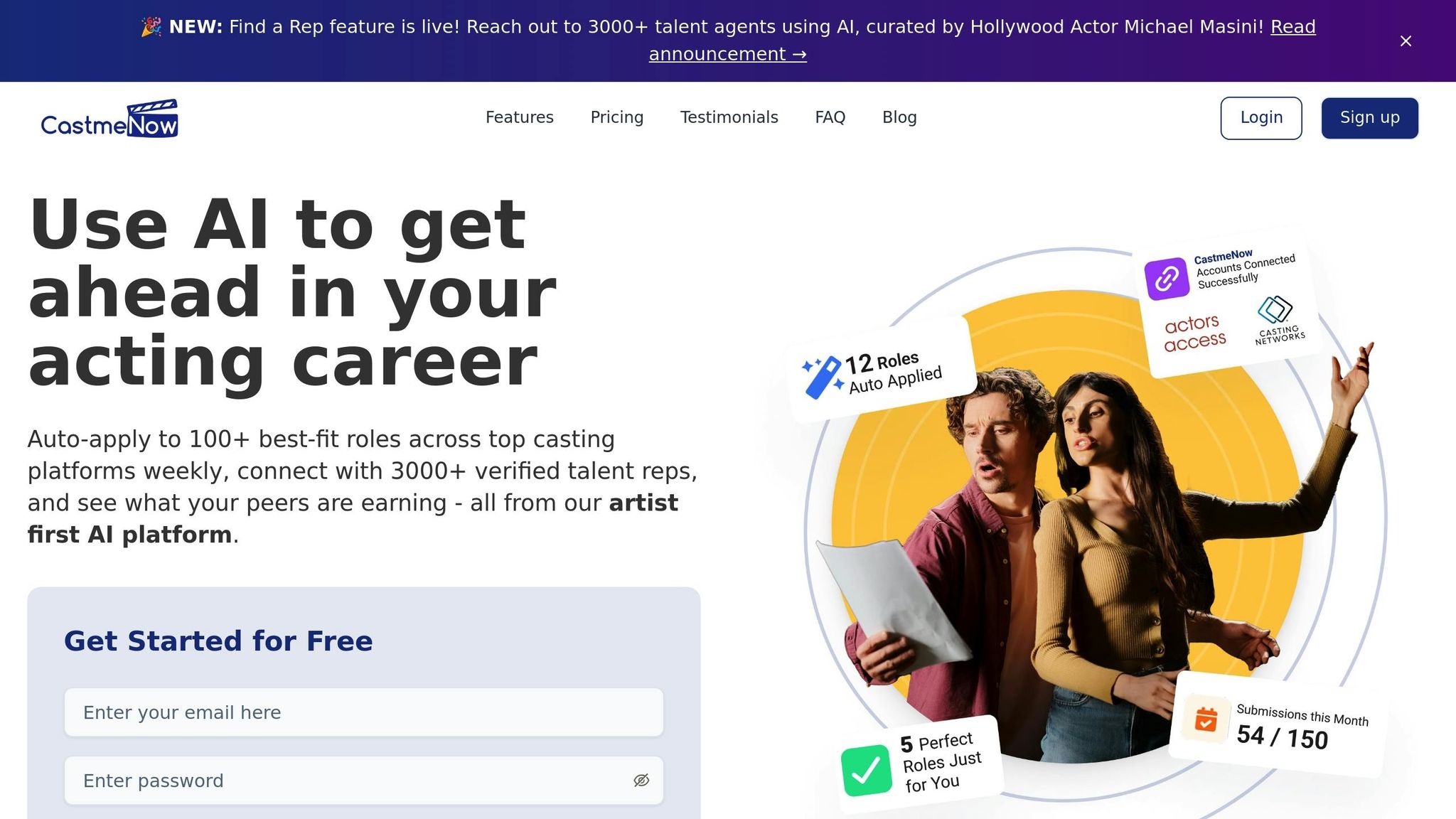AI Bias in Casting: Common Problems and Fixes
AI casting systems risk perpetuating bias against underrepresented actors, but solutions like diverse data and human oversight can promote fairness.

AI is now a major player in casting, helping production teams sort through submissions faster by analyzing headshots, self-tapes, and even emotions. But there’s a problem: bias. When algorithms rely on past data or flawed assumptions, they can unintentionally exclude actors based on race, gender, or age. This isn’t just unfair - it impacts careers and trust in the process.
Here’s what you need to know:
- Bias Sources: AI often mirrors human prejudices in its training data, like favoring certain demographics or physical traits.
- Data Limitations: A lack of diversity in training data means underrepresented groups are often overlooked.
- Overreliance on Numbers: Algorithms may prioritize patterns from past castings, ignoring talent or potential.
Fixes:
- Better Training Data: Use diverse, updated datasets to reduce bias.
- Anonymized Profiles: Remove personal details like name or age during initial screenings.
- Human Oversight: Pair AI with human judgment to ensure nuanced decisions.
Tools like CastmeNow and bias-detection platforms (e.g., IBM AI Fairness 360) are already helping. But the key is combining smarter AI with human input to make casting more inclusive and trustworthy.
Algorithmic Bias and Fairness: Crash Course AI #18
Common Problems: How Bias Affects AI Casting
AI casting systems often struggle with biases rooted in the data they are trained on, leading to skewed talent evaluations. Below, we explore key areas where these biases emerge and discuss their implications.
Hidden Bias in Training Data
One of the biggest challenges with AI casting systems is their reliance on historical data, which often carries the biases of past practices. Instead of objectively evaluating an actor's suitability for a role, these systems can end up mirroring and amplifying existing patterns of discrimination. As Michael Choma aptly notes:
"Bias is a human problem. When we talk about 'bias in AI,' we must remember that computers learn from us."
A striking example of this issue occurred when Amazon's AI recruiting tool penalized resumes containing terms like "women's", reflecting the biases in the data it was trained on. The company ultimately had to scrap the system.
In the casting world, similar problems arise. Decades of industry data that favored certain demographics can lead AI systems to perpetuate these inequalities. For example, research from Queen Mary University found that AI models trained on film industry data displayed gender biases, with actresses facing greater challenges in securing consistent roles compared to their male counterparts. These biases are further entrenched by sample and label inaccuracies, which fail to represent the real world accurately.
Limited Diversity in Data Sets
Another significant issue is the lack of diversity in the datasets used to train AI casting systems. When these systems are exposed to limited examples of actors from underrepresented groups, their ability to evaluate diverse talent is compromised. The historical lack of diversity in the entertainment industry only worsens this problem. A study by the USC Annenberg Inclusion Initiative, covering the years 2007 to 2022, revealed the industry's disappointing track record on improving representation.
This lack of diversity creates what some call an "illusion of diversity". While AI systems may appear to consider a range of candidates, their assessments are often based on a narrow and unrepresentative foundation. As a result, talented actors from marginalized backgrounds may be unfairly overlooked simply because the system has not encountered enough diverse examples in its training.
Facial recognition technology provides a clear parallel. Studies have shown that systems from major tech companies misidentified darker-skinned women at error rates as high as 35%, while error rates for light-skinned men were below 1%. In casting, such disparities could lead to qualified actors being dismissed due to similar biases. Additionally, an overreliance on numerical data only deepens these inequities.
Too Much Focus on Numbers Only
AI systems often prioritize quantifiable traits, which can unintentionally reinforce stereotypes. For instance, these systems might consistently favor actors who match physical or vocal patterns frequently seen in past successful castings, regardless of their actual talent or fit for a role. This tendency risks perpetuating confirmation bias, where the system's recommendations align with historical trends rather than objective assessments.
Writer, director, and producer Justine Bateman highlights the danger of this approach:
"Generative AI can only function if you feed it a bunch of material. In the film business, it constitutes our past work. Otherwise, it's just an empty blender. [It] can't do anything on its own. … So if you keep recycling what we've got from the past, you have nothing new. Nothing new will ever be generated."
Another issue arises when AI models are tested on unrepresentative data, leading to overconfidence in their accuracy. This can result in casting directors placing too much trust in AI recommendations, without fully understanding the system's inability to evaluate the full range of an actor's skills and potential. Ultimately, this overreliance on numbers risks stifling creativity and fairness in casting decisions.
Solutions: How to Fix Bias in AI Casting
Fixing bias in AI casting systems calls for deliberate efforts across various areas. The entertainment industry must adopt strategies that promote fairness and inclusivity, ensuring that casting decisions are based on talent rather than outdated assumptions.
Improving and Checking AI Training Data
The foundation of unbiased AI lies in the quality and diversity of its training data. Andrew Ng, a Stanford AI professor and founder of DeepLearning.AI, puts it succinctly:
"If 80 percent of our work is data preparation, then ensuring data quality is the most critical task for a machine learning team."
To achieve this, it's crucial to collect data from a broad range of sources - such as community theaters and independent productions - and use techniques like adjusting headshot lighting, rotating images, or modifying audio samples to introduce variety. Including underrepresented talent in these datasets is non-negotiable.
Regular reviews of training data are essential to catch and correct any emerging biases . AI systems need to be updated continuously to align with changing societal norms, technologies, and industry trends. This process also involves thorough data cleaning before feeding it into AI systems.
Another key step is assembling diverse teams to oversee data preparation. A mix of perspectives can help uncover biases that might go unnoticed in more uniform groups. These efforts collectively create a strong foundation for fairer AI-driven casting.
Removing Personal Details from Profiles
Blind recruitment methods can further reduce bias when paired with robust data practices. According to Glider.ai, organizations using blind recruitment achieved a 32% increase in hiring diversity.
For casting, this means anonymizing sensitive candidate details - such as name, gender, age, and race - during the initial AI screening. By preprocessing data to remove these attributes, the AI focuses solely on professional factors like performance samples, acting experience, vocal range, and demonstrated skills. Once the initial evaluations are complete, casting directors can access full profiles, ensuring they have all relevant information while minimizing bias during the early stages.
Adding Human Review to Decisions
Even with improved data and anonymization, human oversight remains critical. AI systems need the context and nuance that only human judgment can provide. The European AI Act highlights this necessity:
"Human oversight shall aim to prevent or minimize the risks to health, safety or fundamental rights."
A "human-in-the-loop" approach integrates experienced reviewers at key points in the AI decision-making process. These reviewers can step in when biases are detected or when the system flags uncertainty. In casting, this means that human experts evaluate AI-generated recommendations, especially for lead roles or other pivotal decisions.
Research underscores the importance of this balance. For example, a study on automation bias in mammography screening found that radiologists' accuracy dropped significantly when they relied on incorrect AI suggestions. Similarly, over-relying on AI in casting could lead to missing an actor's unique qualities.
Human reviewers also excel in areas where AI falls short, like assessing on-set chemistry, aligning with a director's vision, or considering other nuanced requirements. Entertainment companies should make human oversight a standard part of AI workflows, training casting professionals to collaborate effectively with AI tools while establishing clear protocols for decision-making.
Tools That Help Reduce Casting Bias
After improving data quality and incorporating human oversight, specialized tools now play a key role in reducing bias in AI-powered casting. These platforms blend automation with transparency features to create fairer opportunities for actors while making the casting process more efficient.
Automated Application Systems
Automated application systems help standardize evaluations, minimizing the influence of human biases.
Take CastmeNow, for instance. This platform connects to major casting hubs like Casting Networks and Actors Access, acting as an automation layer. It allows actors to define their preferences and criteria for roles, and the system matches opportunities based on these parameters. By relying on algorithm-driven matching, CastmeNow reduces the impact of subjective human decisions in candidate selection.
This approach has shown measurable benefits. For example, 48% of HR managers have noted biases in traditional selection processes. Automated systems like CastmeNow counter these tendencies, promoting diversity and enabling faster candidate processing. Some organizations have even reported a 32% increase in diversity among candidates.
But automation alone isn't enough - transparency in AI processes is essential to ensure fairness.
Transparent AI and Open Processes
Transparency tools help build trust in AI-driven casting decisions, a critical factor in reducing bias. Interestingly, the explainable AI (XAI) market is expected to grow significantly, with projections reaching $21 billion by 2030 at an annual growth rate of 18.4%.
Several platforms now offer tools designed to detect and explain biases in AI systems. Here’s a quick overview:
| Tool | Function | Ideal For |
|---|---|---|
| IBM AI Fairness 360 | Offers over 70 fairness metrics and bias mitigation algorithms | Enterprise casting systems using Python workflows |
| Google's What-If Tool | Provides a visual interface to analyze model performance across demographics | TensorFlow-based casting platforms |
| Microsoft Fairlearn | Assesses and improves fairness in machine learning models | Azure-based casting infrastructure |
| Amazon SageMaker Clarify | Detects bias and explains model decisions | AWS-hosted casting applications |
These tools help uncover biases related to sensitive factors like race, gender, or age. By using feature attribution, they clarify AI recommendations for casting directors, making the decision-making process more transparent.
Additionally, tools like Aequitas allow casting teams to evaluate disparities across demographic groups. Metrics such as statistical parity, false positive rate parity, and equal opportunity give detailed insights into where AI systems may unintentionally favor certain groups. With this information, teams can take corrective action and ensure the system remains fair.
However, detecting bias is just the start - regular monitoring is needed to maintain these improvements.
Regular Monitoring and Feedback
Continuous oversight ensures that efforts to reduce bias remain effective in the long run. The most successful systems combine automated monitoring with human review.
Platforms like Fiddler AI and Credo AI provide real-time alerts and governance frameworks, helping users address bias as it emerges. In casting, this means identifying when AI systems start showing patterns of bias and evaluating them against internal policies and global regulations.
To keep systems fair, industry best practices suggest regular audits. These audits involve testing AI models in diverse, real-world scenarios, monitoring outputs for bias, and using specialized tools to assess performance. Proactive measures like these can catch potential issues before they escalate.
Regular audits also serve as a safeguard against legal challenges. With 99% of Fortune 500 companies now using automation in hiring processes, the entertainment industry is under growing scrutiny to ensure algorithmic fairness. Consistent monitoring and governance systems are essential to maintaining fairness and compliance in AI-driven casting.
Conclusion: Building Fair AI Casting Systems
Creating fair AI casting systems is a blend of cutting-edge technology and thoughtful human oversight. The goal is to ensure every actor has an equal shot at landing their next role, without bias clouding the process.
Tackling Bias: Key Strategies
Addressing bias in AI-driven casting isn't just about technology - it's about combining data accuracy with ethical judgment. Three essential steps guide this process:
- Diverse and Inclusive Training Data: Casting systems need datasets that reflect a wide range of demographics to avoid skewed outcomes.
- Ongoing Monitoring: A team of ethicists, social scientists, and industry professionals should regularly assess the system, catching biases before they influence decisions.
- Comprehensive Debiasing Plans: Companies must implement strategies that combine technical fixes, operational improvements, and broader systemic changes.
Legal cases in recent years highlight why human involvement remains critical. While AI can recommend, human judgment is necessary to ensure fairness at every stage.
CastmeNow: A Real-World Solution

Platforms like CastmeNow are already making strides in addressing these challenges. By automating connections to Casting Networks and Actors Access, CastmeNow reduces the influence of human bias while maintaining fairness.
The platform’s algorithm focuses on matching actors to roles based on predefined preferences and requirements, steering clear of subjective judgment. This automation ensures consistency and fairness in applications, giving every actor an equal chance.
What sets CastmeNow apart is its transparency. Actors control their criteria and preferences, deciding which opportunities fit their goals. The system operates continuously, ensuring that timing doesn’t unfairly impact decisions.
CastmeNow also addresses accessibility issues that other AI tools often overlook. For instance, a 2025 University of Melbourne study found that many AI hiring tools struggled with candidates who had speech disabilities or non-native accents. By emphasizing profile matching over speech or video analysis, CastmeNow avoids these barriers, ensuring all qualified actors are considered.
The entertainment industry is under increasing pressure to ensure fairness in AI-driven processes. Platforms like CastmeNow show that when fairness is built into automation, it can reduce bias, open doors for diverse talent, and make casting more efficient for everyone involved.
FAQs
How does AI bias in casting impact actors from underrepresented groups?
AI Bias in Casting: A Barrier for Diverse Talent
AI bias in casting can have a significant impact on actors from underrepresented groups, often reinforcing stereotypes and deepening systemic inequalities. Why does this happen? It’s largely because AI systems are trained on historical data, which often mirrors the entertainment industry’s existing biases. This means these systems may unintentionally favor certain demographics while sidelining a wealth of diverse talent.
While AI holds promise for improving representation by spotting overlooked actors, biased algorithms can do the opposite - limiting opportunities for marginalized groups and continuing the cycle of underrepresentation in media. To tackle these challenges, it’s essential to use more inclusive training data and create safeguards that promote fairness in casting decisions.
How can AI casting systems improve diversity in their training data?
To make AI casting systems more inclusive, it's crucial to include training data that captures a broad spectrum of demographic groups and geographic regions. This approach ensures the AI mirrors a more diverse and representative range of individuals.
Another effective strategy is leveraging data augmentation techniques. These methods can generate a wider variety of examples, particularly for groups that are often underrepresented. By emphasizing unique cases and minority populations, these techniques help minimize bias and create fairer AI models tailored for diverse casting needs. Building inclusivity into the training process ultimately results in casting recommendations that are both fair and accurate.
Why is human involvement essential in AI-powered casting, and how does it reduce bias?
Human participation plays a key role in AI-driven casting, as it helps spot and correct biases that AI systems might unintentionally develop. This ensures casting decisions remain fair, inclusive, and aligned with both ethical principles and legal requirements.
When humans oversee AI processes, it strengthens clarity, responsibility, and confidence in the system. Human judgment adds nuance, ensuring decisions align with shared values and reducing risks such as discrimination or unfair practices. By working together, AI and human input create a more balanced and fair casting approach.

